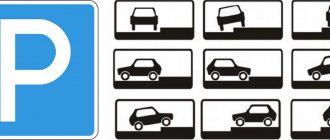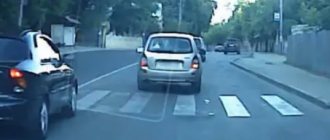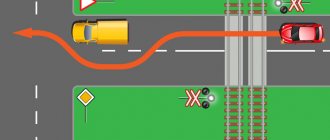Home / Vehicles
Back
Published: 05/20/2020
Reading time: 9 min
0
758
– I live in an old-style apartment building. And we often have a problem with parking - in the evenings we have to look for a place. And some cunning residents park their cars right next to the entrance to the entrance and are very in the way! Are there any legal ways to deal with them?
– Parking of personal vehicles near the entrance of a residential building is prohibited, as this may cause inconvenience to residents of the entrance due to the need to bypass the parked vehicle.
However, you can park vehicles, including personal large ones, in a temporary parking lot - for example, to load things or pick up and drop off passengers, that is, if the car ends up near the entrance for a short time.
- What legal norms are violated when parking near the entrance?
- Is it possible to determine the parking procedure in the local area at a meeting of building residents?
- Where can I complain about a parking violation?
- Measures to be taken against the violator
Parking rules in a residential area
The traffic rules have only 2 rules governing parking in a residential area. Firstly, parking with the engine running is prohibited (to prevent exhaust smoke from entering the apartments). Secondly, parking of category “C” freight vehicles is prohibited. This is all established by clause 17.3, however, in addition to this, the traffic rules have general parking rules that prohibit parking a car on the lawn and on the sidewalk unless there is an appropriate sign nearby that allows such parking.
But parking rules in a residential area are regulated not only by traffic regulations. The Russian Federation has fire safety and sanitary standards, which all citizens must also comply with.
Fire safety standards require that cars be parked so as not to block the entry into the yard for special service vehicles.
And SanPiN 2.2.1/2.1.1.1200-03 establishes the following restrictions on parking near the house:
- parking for 10 cars can be located at a distance of up to 10m from the windows/entrance to the house;
- at a distance of 11-50m from the windows/entrance to the house, parking for 15 cars can be located;
- at a distance of 51-100 m from the windows/entrance to the house, parking for 25 cars can be located;
- at a distance of 101-300 meters from the windows/entrance to the house, parking for 35 cars can be located;
- At a distance of more than 300m from the windows/entrance to the house, parking for 50 cars can be located.
What legal norms are violated when parking near the entrance?
If you park a car near the entrance, the following regulations are violated:
- SanPiN 2.2.1/2.1.1.1200-03;
- clause 17.4 of Chapter 17 of the Traffic Rules;
- paragraph 9 of clause 12.4 of Chapter 12 of the Traffic Rules - prohibition of stopping if such parking blocks opportunities for people to use sidewalks, as well as if it creates difficulty for disabled people to use special connections between sidewalks and the roadway for freer movement.
Possible fines for illegal parking
Fines for illegal parking can be completely different, as they depend on the type of offense:
- parking on the sidewalk - 1000 rub. (in Moscow and St. Petersburg - 3000 rub.);
- creating obstacles to the movement of other vehicles - 2000 rubles (in Moscow and St. Petersburg - 3000 rubles);
- creating obstacles for a fire truck or ambulance - 500-2000 rubles. (if people died or were injured because of the obstacle, then you can also receive criminal punishment);
- parking on the lawn - up to 5000 rub. depending on the region (the fine is set by the regional Code of Administrative Offences);
- parking near garbage containers - up to 5000 rubles. depending on the region (the fine is set by the regional Code of Administrative Offences);
- creation of an illegal parking space with fences – RUR 5,000.
Tow truck payment
A fine is not the only thing that awaits an illegally parked driver. If a parked car interferes with vehicles or pedestrians, traffic police officers can send it to the impound lot. For the evacuation itself and for each day the vehicle is kept in the parking lot, the driver will have to pay a fairly large amount. More details about the rules and cost of evacuation, as well as impound parking tariffs, can be found in a separate article “Fine for evacuation of a car.”
Parking on the sidewalk
In this case, everything becomes clear; several points of the Rules are violated here:
- Parking in front of the entrance on the sidewalk is not allowed, as stated in section 12 of the traffic rules.
- Interference is created for pedestrians - clause 12.4.
The only exception may be stopping on the sidewalk if you need to load or unload goods, as stated in traffic rules, clause 9.9. But the Rules say that this must be the shortest path. To do this, you will need to prove to the traffic police inspector that if you moved 10 meters from the road, loading would become impossible.
In addition, the Rules mean that you will constantly be near the car so that it is not evacuated to the impound lot.
In other cases , parking is prohibited near the entrance of the house if it interferes with the passage of pedestrians . This is written in the Rules, paragraph 12.4. In residential areas, cars and other vehicles must give way to pedestrians. What does it mean to create interference? This forces the pedestrian to change direction or walking speed. Therefore, if your car even slightly blocks the path to the entrance, then the traffic rules are violated.
Fight against violators
The traffic police do not patrol the yards, so the problem with parking violators will not be solved by itself. Of course, residents themselves can take illegal measures (scratch the body, damage the tires, and so on), unfortunately, quite often this is exactly what happens. But these methods can lead to an even greater aggravation of the conflict, and if the pest is caught, then to problems with the law.
It is much more effective to deal with a violator within the framework of the law. To do this, citizens have 4 ways:
- Call the traffic police.
- Submitting a written application.
- Filing a complaint via the Internet.
- Filing a complaint through the application.
The simplest method of punishment is to call the traffic police directly to your yard. Another advantage of this method is that the violator will not only be fined, but also have the car towed. But this method also has a rather significant disadvantage - you will have to wait quite a long time for the traffic police officers; perhaps during this time the offender will have time to remove his car. You can call inspectors by calling the general number 102 or by calling the number of the duty station in your area.
A written complaint is submitted to the traffic police department. It is drawn up in free form, but must have evidence - photographs, which must clearly depict the violation itself and clearly show state registration numbers.
A more convenient option for filing a complaint is using the Internet. You can complain about a violator both through the official website of the traffic police and through special applications for smartphones: “Moscow Assistant” - for residents of the capital, Spot - for residents of the regions. Any of these methods speeds up the process of filing a complaint and relieves the citizen of the need to visit traffic police departments. But filing an online complaint should also not be groundless: it must be accompanied by photographs or videos that prove the fact of the violation and clearly display the vehicle’s license plate number.
Demolition of parking barriers in the yard
Another problem that can be caused by unscrupulous neighbors is the installation of illegal parking barriers. Brazen violators install various posts, chains, and fences in the yard, thereby “reserving” a parking space. Such actions are also illegal.
There are several ways to combat this:
- Get rid of barriers yourself. If they are installed on public property illegally, then any resident has every right to dismantle them themselves. At the same time, it is important not to damage the road surface yourself, so as not to later be guilty of damaging public property. It is also worth thinking about possible personal problems with the parking space invader.
- Contact the local police officer. If a car is parked in a legally created parking space, and the problem is only a fence that prevents other residents from using the parking lot, then the traffic police will be powerless. In this case, citizens can call the local police officer or write a statement. It will be his responsibility to stop the violation and punish the culprit.
- Contact the Criminal Code. Management companies are also authorized to demolish illegal structures, and many companies will do this much faster than the police. However, everything depends on the company itself: managers of prestigious residential complexes quickly deal with violators, and ordinary housing and communal services may require the preparation of a collective complaint, delaying the process in the hope that the problem will be solved by itself. Another drawback of this method: the Criminal Code cannot punish the violator; its powers only include getting rid of the illegal fence.
- Contact the city administration. The last method is the longest; It is worth using it only if other methods have not brought any results. The city administration will consider the complaint for a month. As a result, she may oblige the Criminal Code to demolish the fence, and instruct the police to impose a fine on the violator. In this case, both the Criminal Code and the district police officer will definitely stop being inactive.
Illegal parking barriers in the yard
In some cases, neighbors not only block the path, managing to park their car in the wrong place, but also “reserve” the space by installing all kinds of posts, iron chains and other tricks. How to deal with them?
There are several options to solve this problem:
- Get rid of obstructions on your own
If for the thousandth time selfish motorists have ignored your persistent requests to comply with the law on the construction of local areas, it’s time to act. Remove illegal traffic obstructions yourself. This method has one significant drawback: such actions are fraught with complications of conflict with neighbors;
- Appeal to the district police officer
If you are far from using forceful methods to solve the problem, another way out is to contact the local police officer or the police stronghold in your area. They are obliged to respond to the application, issue a fine and force them to remove the car;
- Contacting the housing department
You can also write a statement to your housing office and demand that the illegal barrier be removed. The problem must be resolved within one calendar month;
- Contacting the city administration
You are given 1 month to process your application, after which all barriers must be removed without fail, and if it is proven that a parking space has been illegally arranged on a state-owned plot of land, the car owner will pay a fine.
- If unscrupulous drivers have caused damage to the road surface near your home or in the surrounding area or become an obstacle to the passage of other vehicles, feel free to contact the traffic police directly. Such matters are within their competence.
- Contacting the Illegal Parking Commission
Unfortunately, special commissions today exist only in large cities (such as Moscow and St. Petersburg).
Where to park in the yard?
And at the end of the article about methods of dealing with parking violators, I would like to provide a list of permitted parking methods:
- Equipped parking in the yard. This is the most obvious and most preferred option. If free parking in the yard is available, then it is better to leave the car there, and not try to park right at the entrance to the entrance. Unfortunately, such parking is often not enough to accommodate all of the residents' vehicles.
- Paid parking for residents of the house. Some residential complexes sell not only apartments, but also separate parking spaces in the yard. Thus, part of the parking lot becomes private: the number of the car for which the space is intended is indicated on the asphalt, and at the request of the owner of the parking space, the management company itself can install legal barriers.
- Paid garages or parking lots. The main disadvantage of this method is the distance from housing. In addition, the car owner will have to pay for parking. However, this method also has an advantage: paid parking lots are guarded and under video surveillance, which means the driver does not have to worry about the safety of his property. If the parking lot is indoors, then in winter it has another advantage: the car does not have to be dug out from under the snow and warmed up.
Traffic regulations regarding the prohibition of parking on sidewalks
We turn to Chapter 12 “Stopping and Parking” and find the following regarding stopping (parking) on the sidewalk.
12.1. Stopping and parking of vehicles is permitted... established by paragraph 12.2 of the Rules - on the sidewalk. 12.2...Parking on the edge of the sidewalk bordering the roadway is permitted only for cars, motorcycles, mopeds and bicycles in places marked with sign 6.4 with one of the signs 8.4.7, 8.6.2, 8.6.3, 8.6.6 - 8.6. 9.
That is, if only there is a sign 6.4, and under it there are requirements for parking on this sidewalk, right up to driving onto it, then this will not be a violation. Everything else is prohibited!
Let us say right away that such a combination of signs, especially with driving onto the sidewalk, is extremely rare, so almost any attempt by the driver to drive onto this violation. And according to the novel of the great writer, and according to the norms of the law, a crime is followed by punishment.








